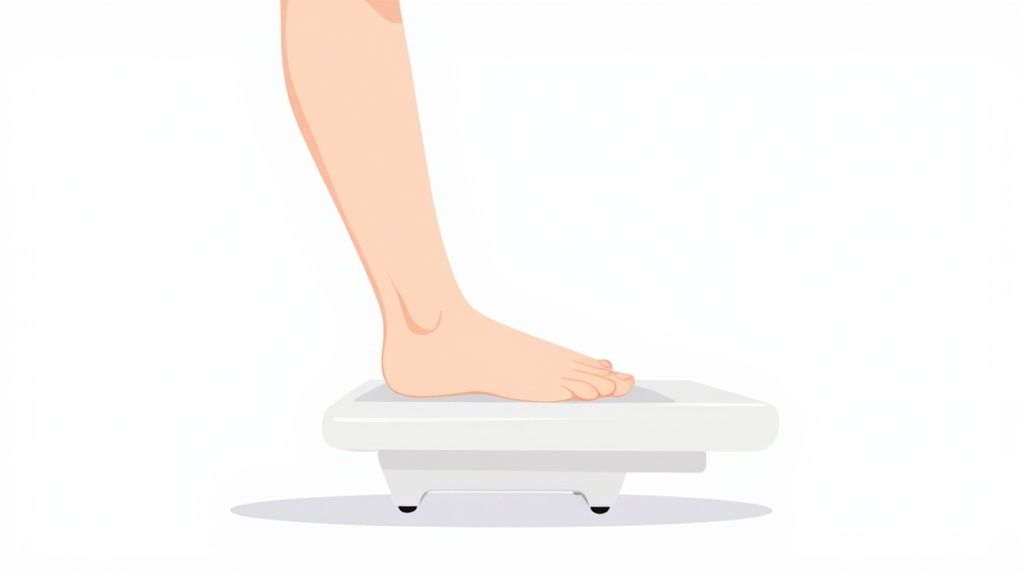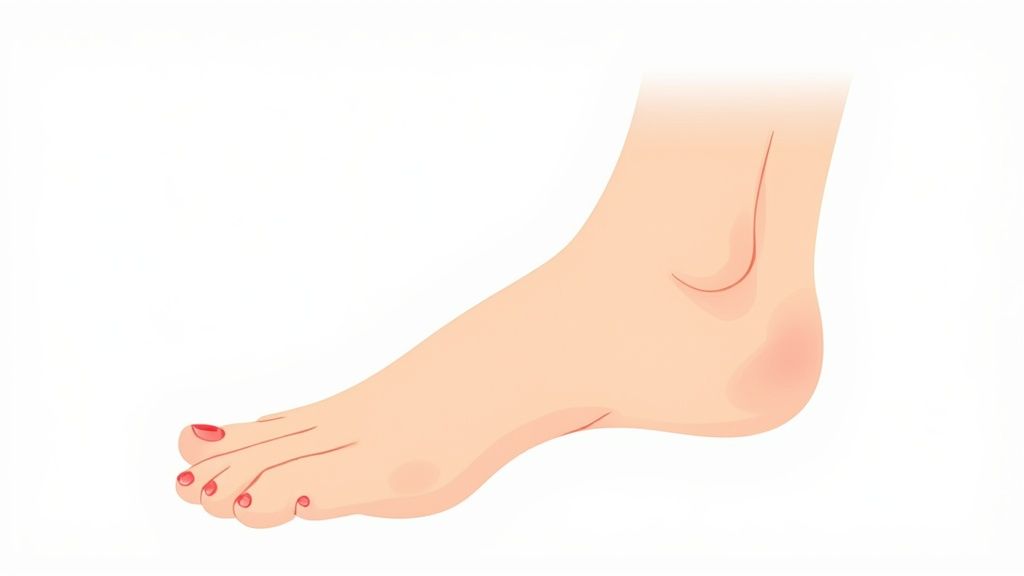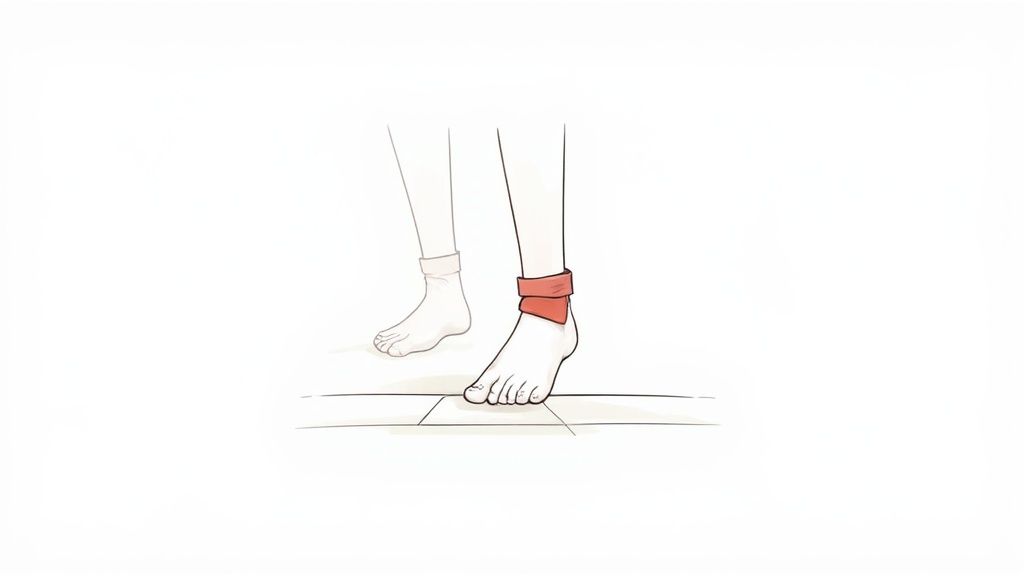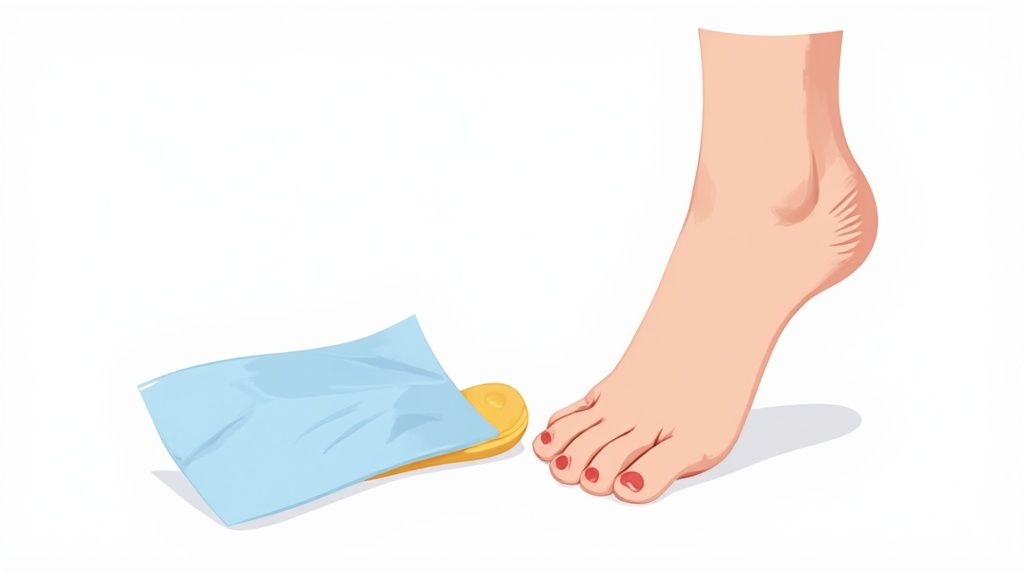If you've ever felt a sharp, stabbing pain in your heel with your first step out of bed, you've likely met plantar fasciitis. It's one of the most common foot problems out there, but what exactly is it?
At its core, plantar fasciitis is an overuse injury. It happens when the plantar fascia—a thick, powerful ligament that runs along the bottom of your foot—gets strained, inflamed, and irritated. This isn't usually from one big event, but from the cumulative stress of daily life.
What Is Plantar fasciitis and Why Does It Hurt?
Think of your plantar fascia as a crucial shock absorber, a strong, bowstring-like band connecting your heel to the base of your toes. Every step you take, it supports the arch of your foot and absorbs the impact. It’s an elegant piece of natural engineering.
But when you put this "bowstring" under too much tension for too long, it starts to fray. The constant strain from things like standing on hard surfaces all day, a sudden increase in running mileage, or wearing shoes with poor support creates tiny micro-tears in the ligament. Your body responds to this damage with inflammation, and that inflammation is what causes that signature, debilitating pain in your heel.
The Mystery of Morning Pain
One of the tell-tale signs of plantar fasciitis is that excruciating pain you feel with your very first steps in the morning. Ever wonder why it’s so bad right after you wake up?
Overnight, while you sleep, your foot is typically in a relaxed, pointed position. This allows the inflamed plantar fascia to shorten and contract. When you suddenly stand up, you forcefully stretch that tight, cold, and unhappy ligament, triggering a jolt of intense pain. As you walk around a bit, the tissue warms up and loosens, which is why the pain often eases into a dull ache. But it can easily come roaring back after you’ve been sitting for a while.
And you're not alone if you're dealing with this. It's an incredibly widespread issue. Research consistently shows that about 1 in 10 people will grapple with plantar fasciitis at some point in their life, with similar rates seen across the US, UK, and Canada. You can dive deeper into these global prevalence rates to see just how common it really is.
To put it all in one place, here's a quick rundown of the condition.
Plantar Fasciitis at a Glance
| Factor | Description |
|---|---|
| What It Is | Inflammation and micro-tearing of the plantar fascia, the thick ligament on the bottom of the foot. |
| Primary Symptom | Sharp, stabbing pain in the bottom of the heel. |
| When It's Worst | Typically with the first few steps after waking up or after long periods of rest. |
| Root Cause | Repetitive strain and overuse that overwhelms the ligament's ability to repair itself. |
| Common Triggers | Prolonged standing, high-impact activities (running, jumping), unsupportive footwear, sudden weight gain. |
This table shows that while the pain is specific, the causes are often related to our daily habits and activities.
Key Takeaway: Plantar fasciitis is not a sudden injury but a gradual breakdown. It's the result of repetitive stress piling up over time, day after day, until the ligament simply can't keep up.
This is exactly why it affects so many different people, not just elite athletes. Anyone who spends a lot of time on their feet is at risk:
- Teachers, nurses, and retail workers who stand for hours on unforgiving floors.
- Factory or warehouse employees whose jobs demand constant walking.
- Weekend warriors who ramp up their activity level too quickly without giving their bodies time to adapt.
Understanding that this is a problem of repetitive strain is the first and most important step. Once you grasp that, you can start to figure out how to break the cycle, find real relief, and stop the pain from coming back.
The Mechanics of How Your Foot Develops Pain

To really get why your foot hurts, it helps to think of it as a finely tuned machine. Every single step you take is part of a complex chain reaction, designed to both push you forward and absorb the shock of hitting the ground. The star player in all this is your plantar fascia, that thick, tough band of tissue running along the bottom of your foot.
Think of it as a bowstring on a bow. When you step down, your foot flattens a bit, and the plantar fascia stretches taut. As you lift your heel to push off, this tension is released, giving your step a springy, efficient boost. This is what experts call the "windlass mechanism," and it’s what gives your stride its natural bounce.
When everything is working in harmony, this process is completely seamless. The trouble starts when something in that mechanical chain is out of sync. This throws an enormous amount of stress directly onto the plantar fascia, forcing it to do a job it was never meant to do alone.
When Your Gait Goes Wrong
One of the most common culprits behind this breakdown is overpronation. It's a technical-sounding term for a simple problem: your foot rolls too far inward when you walk. Instead of the force of your step being spread evenly, overpronation makes your arch collapse more than it should, which violently yanks and stretches the plantar fascia.
It's like taking a rubber band and repeatedly stretching it way past its limit. After a while, that rubber band will start to fray and develop tiny tears. That's a perfect picture of what's happening inside your foot with every step.
The Biomechanical Breakdown: Faulty mechanics, especially overpronation, create a cycle of repetitive strain. This consistent pulling and stretching leads to micro-tears and inflammation in the plantar fascia, which is the direct cause of the pain you feel.
Your body desperately tries to heal these tiny injuries, but if the bad mechanics aren't corrected, you keep re-injuring the tissue faster than it can repair itself. This is what leads to chronic inflammation and a weak, painful ligament. And the strain isn't always just in your heel; you can learn more about how plantar fasciitis can cause ankle pain from our team.
The Ripple Effect of Misalignment
It isn't just about overpronation, though. Other mechanical hitches can overload the plantar fascia and set the stage for pain.
- Tight Calf Muscles: If your calf muscles are chronically tight, they constantly pull on your heel bone. This limits your ankle's range of motion and forces the plantar fascia to pick up the slack, absorbing way more stress than it should.
- Weak Foot Muscles: The small, deep muscles inside your foot are crucial for supporting your arch. When they’re weak, your arch becomes less stable, leaving the plantar fascia to overwork and compensate for the lack of support.
- High Arches or Flat Feet: Both ends of the spectrum can disrupt your natural walking pattern. Very high, rigid arches are often poor shock absorbers, while flat feet tend to go hand-in-hand with overpronation. Either way, the plantar fascia takes a beating.
Getting a handle on these mechanics is the first real step toward finding a solution that works. Once you pinpoint the root cause of the strain—whether it’s how you walk, muscle tightness, or the shape of your foot—you can start fixing the actual problem instead of just chasing the pain.
How Your Job and Lifestyle Can Lead to Heel Pain

While your foot's structure is important, the real story behind most cases of plantar fasciitis is found in our everyday lives. The things you do day in and day out—at work, at the gym, and just living—can create the perfect storm for heel pain.
Let's dig into how your daily grind might be the root cause of that nagging ache in your heel.
When Your Job Is the Culprit
For many people, the path to plantar fasciitis starts the moment they clock in for work. If your job has you standing, walking, or pacing for hours on end, you're putting your feet through a marathon every single day.
Hard, unforgiving surfaces like concrete or tile offer zero shock absorption, forcing the plantar fascia to take the full impact of every step. This constant strain is a major problem for people in certain professions:
- Nurses and healthcare workers who spend entire shifts on their feet.
- Retail and hospitality staff who are always standing and moving.
- Teachers who stand in front of a classroom all day.
- Factory and warehouse workers who walk on concrete floors for hours.
When your job demands this much from your feet, having solid workplace injury prevention strategies in place isn't just a good idea—it's essential for your long-term foot health.
The following table breaks down some of the most common risk factors and how they contribute to plantar fasciitis.
Common Risk Factors for Plantar Fasciitis
| Risk Factor | How It Contributes | Affected Groups |
|---|---|---|
| Occupational Demands | Prolonged standing or walking on hard surfaces increases repetitive strain. | Nurses, Teachers, Retail Workers, Factory Staff |
| High-Impact Activities | Sudden increases in running or jumping overload the fascia. | Runners, Athletes, Fitness Enthusiasts |
| Excess Body Weight | Adds significant, constant pressure to the foot with every step. | Anyone carrying extra weight. |
| Age | The fascia loses elasticity and the heel's fat pad thins over time. | Adults aged 40-60. |
| Foot Mechanics | Flat feet or high arches can alter weight distribution and stress the fascia. | Individuals with non-neutral foot types. |
Understanding these factors is the first step toward figuring out why you're in pain and what you can do about it.
The Impact of Activities, Weight, and Age
Your job isn't the only factor. A sudden jump in your exercise routine—like training for a 5K or starting a new high-intensity class—can easily overwhelm the plantar fascia, causing inflammation and tiny tears in the tissue.
Extra body weight also plays a huge role. Every additional pound you carry multiplies the force on your feet with each step, putting your plantar fascia under constant, heavy stress. It’s a major risk factor that shouldn't be overlooked. You can learn more about these influences in our guide covering key factors you should know about what causes plantar fasciitis.
The Load Factor: Think of your plantar fascia like a rope. Both intense exercise and extra body weight constantly pull and stretch that rope. Over time, it gets frayed and weak, making it much more likely to get injured.
Age is another piece of the puzzle. As we get older, typically between the ages of 40 and 60, the plantar fascia naturally becomes less flexible. At the same time, the protective fat pad on our heel starts to thin out, leaving us with less natural cushioning.
Interestingly, studies also show women tend to be more susceptible than men. One major analysis revealed that 62% of people diagnosed with plantar fasciitis were female. Recognizing all these factors helps paint a clearer picture of why some of us are more prone to this frustrating condition.
How Your Shoes and Foot Shape Contribute to Strain

While your daily routine certainly puts a load on your feet, the real culprits behind the strain are often much closer to home: your shoes and the natural shape of your feet. Think of your footwear as the foundation for your entire body. If that foundation is shaky or unsupportive, the stress travels right up the chain, and your plantar fascia is usually the first thing to cry out in protest.
One of the most frequent mistakes I see is people wearing flimsy, unsupportive shoes. We’re talking about those thin flip-flops, sneakers that have long lost their cushioning, or dress shoes that are completely flat. Footwear like this offers next to no arch support, forcing the small muscles in your feet and the plantar fascia itself to work double-time just to maintain a stable arch.
Imagine asking a small crew of workers to do the job of a massive industrial crane. They'd burn out pretty fast, right? That’s exactly what happens to your feet. This constant overwork leads to exhaustion and failure, causing the plantar fascia to overstretch and develop the tiny tears and inflammation that signal plantar fasciitis.
Your Natural Foot Structure Matters
Beyond what’s in your shoe closet, the way your feet are built plays a huge part in this story. Your arch type determines how force is distributed every time your foot hits the ground. The two extremes—very high arches and flat feet—are both known to create mechanical issues that put your plantar fascia squarely in the danger zone.
Key Insight: This isn't about having "good" or "bad" feet. It’s all about the interaction between your unique foot shape and the ground. When your footwear doesn't properly support your foot's mechanics, you're creating a perfect recipe for how you get plantar fasciitis.
Let's break down how these different foot shapes can lead to trouble:
- Flat Feet (Low Arches): If you have flat feet, you likely overpronate, meaning your foot and ankle roll too far inward when you walk. This motion flattens the arch even more, creating a constant tugging and pulling stress on the plantar fascia.
- High Arches (Pes Cavus): On the flip side, someone with very high and rigid arches has the opposite problem. Their feet are often poor shock absorbers because the arch doesn't flatten enough to distribute impact. This concentrates a huge amount of pressure on the heel and the ball of the foot, which in turn overloads an already tight and strained plantar fascia.
Choosing the Right Defense for Your Feet
The good news is that you have a ton of control over this. Picking shoes that actually match your foot type isn’t just about feeling comfortable—it’s one of the most powerful preventative measures you can take. If you have flat feet, you should be looking for shoes that provide excellent stability and motion control to keep your arch from collapsing.
If you have high arches, your mission is to find footwear with incredible cushioning. This helps absorb the shock that your rigid foot structure can’t handle on its own. By simply making a conscious choice to wear supportive shoes, you can dramatically cut down the daily strain on your plantar fascia, stop the cycle of damage, and finally give your feet a chance to heal.
Simple and Effective Ways to Prevent Plantar Fasciitis

Knowing what causes plantar fasciitis is half the battle. The other half? Actively preventing it from ever starting. And the good news is, you don't need complicated medical treatments to do it. Prevention really boils down to simple, consistent habits that shield your feet from the daily grind.
Think of it like taking care of your car. You don't wait for the engine to seize up before getting an oil change. In the same way, you shouldn't wait for stabbing heel pain to sideline you before you start looking after your feet. A little proactive care goes a long, long way.
Build a Strong Foundation with Supportive Footwear
Your shoes are your first and best line of defense. Wearing flimsy, unsupportive shoes is basically asking your feet to run a marathon on pavement without any help. It forces your plantar fascia to work overtime, absorbing far more shock than it was ever designed to handle.
Be intentional about choosing shoes with solid arch support and plenty of cushioning. Try to avoid walking barefoot for long stretches, especially on hard surfaces like tile or concrete. If you have a pair of shoes you love that just aren't cutting it in the support department, a high-quality orthotic insole can make all the difference.
Key Principle: The whole point of your footwear is to work with your foot's natural mechanics, not against them. Good shoes lighten the daily load on your plantar fascia, giving that hard-working tissue a chance to recover instead of being constantly strained.
The Power of Stretching and Flexibility
Tight muscles are a classic culprit behind plantar fasciitis. When your calf muscles, in particular, get tight, they pull on your heel bone. This, in turn, creates a constant, nagging tension on your plantar fascia. Just a few simple stretches integrated into your daily routine can make a massive difference.
- Calf Stretches: Gently stretch your calves a few times a day. This is especially important before and after exercise. The classic runner's stretch against a wall is perfect.
- Foot Stretches: Before you even swing your legs out of bed in the morning, gently pull your toes back toward your shin and hold for 30 seconds. This simple move gives the plantar fascia a gentle stretch before it has to handle your full body weight.
- Towel Curls: Sit in a chair, place a small towel on the floor, and use just your toes to scrunch it toward you. This is a great way to strengthen the small, intrinsic muscles in your feet that provide crucial support.
If you're already noticing some mild heel pain, checking out a complete guide on what to do for plantar fasciitis can offer even more strategies for finding relief.
Manage Your Load and Listen to Your Body
Finally, two other huge factors in prevention are managing your body weight and paying attention to your body's early warnings. Every extra pound you carry adds a surprising amount of pressure to your feet, increasing the strain on your plantar fascia with every single step. Keeping a healthy weight is one of the most powerful long-term strategies for happy, pain-free feet.
Most importantly, never ignore pain. If you feel that little twinge in your heel after a long day or a tough workout, that’s your body sending up a flare. Don't be a hero and push through it. Instead, see it as a signal to rest, stretch, and take a hard look at your footwear. Catching the problem early is the absolute key to stopping full-blown plantar fasciitis in its tracks.
Got Questions About Plantar Fasciitis? You're Not Alone.
When that sharp, stabbing pain shows up in your heel, it’s natural to have a million questions running through your mind. Figuring out the "why" and "what now" is the first step toward getting back on your feet, literally. Let's walk through some of the most common questions people have when they're staring down a case of plantar fasciitis.
Can Plantar Fasciitis Just Show Up Overnight?
It certainly feels that way, doesn't it? You go to bed feeling fine and wake up to a shocking, sharp pain with your first step. But the truth is, plantar fasciitis is rarely a sudden event.
Think of the plantar fascia like a rope. The intense pain you feel one morning isn't the rope suddenly snapping; it’s the result of that rope fraying, strand by strand, over weeks or even months. Every day, small activities create tiny micro-tears in the tissue. Your body does its best to patch things up, but eventually, the damage starts to win. That morning pain is the tipping point—the moment all that slow-building strain finally boils over into serious inflammation. Often, a single event, like a long run or a day spent in flimsy shoes, is just the final straw.
Will This Pain Go Away on Its Own?
We all hope for a simple fix, but waiting for plantar fasciitis to magically disappear is a gamble. For a very minor case, a little rest might do the trick. If you overdid it one day and the pain is mild, taking it easy for a bit might be enough for it to fade.
However, for most people, the condition sticks around unless you actively do something about it.
Key Takeaway: The single worst thing you can do is ignore the pain and push through it. When you don't address the underlying issues—like unsupportive shoes, tight calf muscles, or how your foot moves—the problem can dig in and become a chronic issue that’s much tougher to solve later on.
Taking early, simple steps gives the tissue a fighting chance to heal properly. It's the difference between dealing with a short-term annoyance and fighting a long-term battle.
Do I Have to Stop Exercising if I Have Plantar Fasciitis?
Absolutely not! In fact, staying completely sedentary can make things worse by causing your foot and leg muscles to get stiff. The goal isn’t to stop moving; it's to move smarter. You need to temporarily ditch the activities that cause that sharp, shooting pain.
The main offenders are high-impact exercises that pound your feet. For now, you'll want to take a break from:
- Running, especially on hard surfaces like concrete or a treadmill.
- Jumping activities like those in HIIT workouts or plyometrics.
- Sports with lots of sudden stops and pivots, such as tennis, basketball, or soccer.
Swap these out for low-impact options that get your heart rate up without stressing your heels. Swimming, cycling, and using an elliptical are all fantastic choices. They keep you fit while giving that inflamed fascia the break it desperately needs to heal. Your body's signals are your best guide: if an activity hurts, stop and find an alternative.
Are you tired of heel pain dictating your day? The right support can make all the difference. Samurai Insoles are designed by a podiatrist to specifically target the root mechanical cause of plantar fasciitis, giving your feet the stability and relief they need. Check out our insoles and take the first step toward a pain-free life at https://samuraiinsoles.com.



